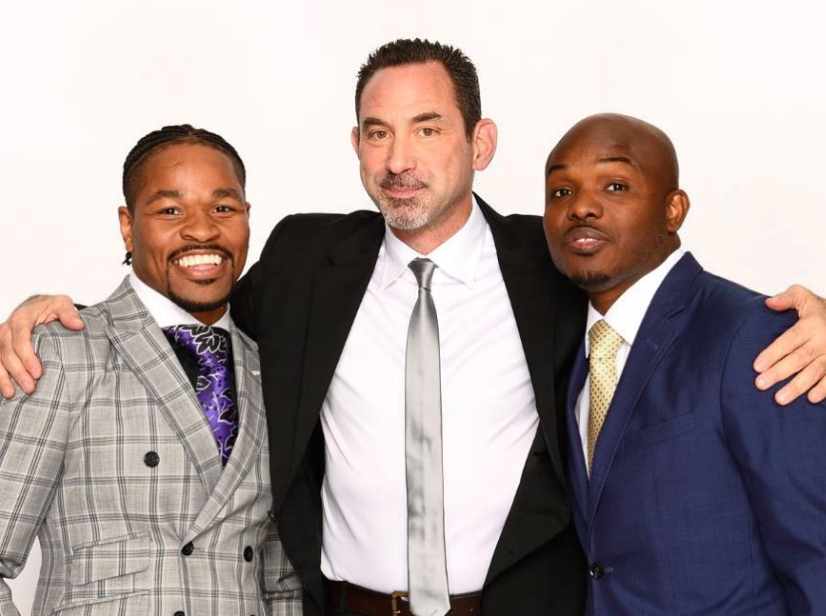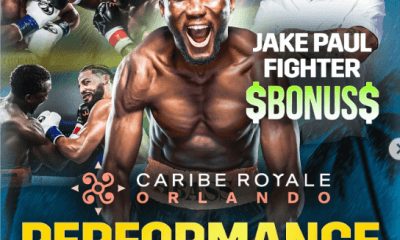Featured Articles
Kriegel and Coppinger clench Bernie Awards; an HM ‘4-Pack’ for the award’s Namesake

The Boxing Writers Association of America has announced the winners of the 18th annual Bernie awards. The awards acknowledge outstanding writing in six categories: Event Coverage, Column, News Story, Feature Story Over 1,500 Words, Feature Story Under 1,500 Words, and Investigative Reporting.
The big winner this year (for stories published in 2019) is author, ESPN TV boxing analyst, and ESPN.com writer Mark Kriegel who accomplished the hat trick, finishing first in Event Coverage, first in Feature Story Under 1,500 words, and tied for first with three of his colleagues in Feature Story Over 1,500 Words. Kriegel (pictured with Shawn Porter and Timothy Bradley) also recorded a third-place finish in the category of Best Column and received an Honorable Mention in the category of Investigative Reporting.
Kriegel has earned six first-place finishes in the last three years alone. With this year’s haul, said BWAA President Joseph Santoliquito in his press release, “(Kriegel) solidified his credentials as perhaps the finest boxing writer in America.”
Mike Coppinger of The Athletic ran a close second. Coppinger finished first in News Story and in Investigative Reporting and received an honorable mention for Event Coverage. Ron Borges, a perennial award winner, likewise received two first-place finishes, sharing the award for Best Column with Sports Illustrated senior writer Greg Bishop and sharing the award for Best Feature Story Over 1,500 words with Kriegel, Carlos Acevedo (Hannibal Boxing), and Lance Pugmire (The Athletic).
The Sweet Science has performed well in this competition over the years, but this year was limited to five Honorable Mentions, four of which came from the pen of 2020 International Boxing Hall of Fame inductee Bernard Fernandez.
Click on the dates of publication below to summon up each of the stories for which Fernandez was recognized:
NEWS STORY: Harold Lederman’s Distinctive Voice Has Been Stilled and Boxing is Poorer for It (published on May 12).
BOXING FEATURE UNDER 1,500 WORDS: The Patterson vs Johansson Fight Could Never Happen Now as it Did Then (published on June 20).
BOXING FEATURE OVER 1,500 WORDS: Holmes-Spinks I: The Grassy Knoll for Boxing’s Conspiracy Theorists (published on Sept. 16).
EVENT COVERAGE: New Champ Teofimo Lopez Continues Upstaging Bigger Names: Lomachenko Next? (published on Dec. 15).
The Bernie Awards, it should be noted, were named for Bernard Fernandez, a former five-term BWAA president. Lest anyone think that it isn’t kosher for Fernandez to compete for an award named for himself, it should be noted that the judging is done on the blind, meaning that all bylines and other identifying marks, including the publication or web site for which the story was written, are omitted from the copies that the judges receive.
Over the last decade or so, no writer whose work has appeared in these pages has received more BWAA writing awards than Springs Toledo. This year, the multi-decorated Toledo received an Honorable Mention for a story we published on June 3 titled “Joshua vs. NYC.”
The Bernie awards for 2019 attracted a record number of entries. The submissions were evaluated by nine judges, a distinguished panel that included former sports columnist and prolific author Ira Berkow who shared the 2001 Pulitzer Prize for National Reporting for his contribution to the New York Time series “How Race is Lived in America.”
John Whisler (San Antonio-Express News), Jim Jenkins (Sacramento Bee), and Chuck Bausman (Philadelphia Daily News), the latter of whom is an adjunct professor in the Department of Communications and Journalism at Rider University, completed the roster of retired newspapermen. Joining them were venerable Dayton Daily News columnist Tom Archdeacon and Tommy Deas of the USA Today Sports Network, a past president of the Associated Press Sports Editors.
The world of academia was represented by authors Sean Patrick Griffin (Professor of Criminal Justice, The Citadel) and Todd D. Snyder (Associate Professor of English, Siena College). Rounding out the panel was prominent sports marketing consultant Rich Rose, the former President and COO of Caesars World Sports who was involved with boxing at Caesars Palace in Las Vegas when that property’s motto was “Home of Champions.”
Under normal circumstances, the award winners would be recognized at the BWAA’s annual awards dinner which this year would have likely materialized in May. Unfortunately, what would be the organization’s 94th annual event has been left hanging by the COVID-19 epidemic and, notes Santoliquito, “might even have to be pushed back into 2021 should the need arise.”
Check out more boxing news on video at The Boxing Channel
To comment on this story in The Fight Forum CLICK HERE
-

 Featured Articles3 weeks ago
Featured Articles3 weeks agoThe Hauser Report: Cinematic and Literary Notes
-

 Featured Articles4 weeks ago
Featured Articles4 weeks agoOscar Duarte and Regis Prograis Prevail on an Action-Packed Fight Card in Chicago
-

 Book Review3 weeks ago
Book Review3 weeks agoMark Kriegel’s New Book About Mike Tyson is a Must-Read
-

 Featured Articles1 week ago
Featured Articles1 week agoThe Hauser Report: Debunking Two Myths and Other Notes
-

 Featured Articles2 weeks ago
Featured Articles2 weeks agoMoses Itauma Continues his Rapid Rise; Steamrolls Dillian Whyte in Riyadh
-

 Featured Articles4 weeks ago
Featured Articles4 weeks agoRahaman Ali (1943-2025)
-

 Featured Articles4 weeks ago
Featured Articles4 weeks agoTop Rank Boxing is in Limbo, but that Hasn’t Benched Robert Garcia’s Up-and-Comers
-

 Featured Articles3 weeks ago
Featured Articles3 weeks agoKotari and Urakawa – Two Fatalities on the Same Card in Japan: Boxing’s Darkest Day




















